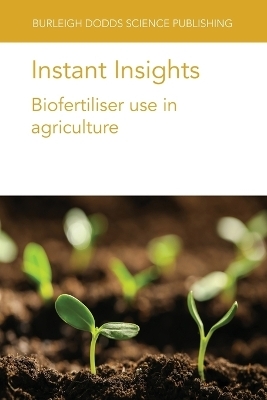
Instant Insights: Biofertiliser Use in Agriculture
Burleigh Dodds Science Publishing Limited (Verlag)
978-1-80146-675-2 (ISBN)
This book features five peer-reviewed reviews on biofertiliser use in agriculture.
The first chapter examines the role of biofertilisers and consortia of microorganisms to improve the effectiveness of organic fertilisation, before moving on to consider the use of animal excrement, including manures, slurry and guano.
The second chapter presents the key issues in the optimum use of treated wastes in crop nutrition. The chapter also discusses technical processes such as precipitation of salts, incineration and post-treatment of ashes, as well as production of carbonaceous materials.
The third chapter discusses some common issues regarding the use of bio-based fertilisers, such as the concentration of nutrients leading to losses of reactive nitrogen and phosphorus into the environment.
The fourth chapter addresses the key issues of arbuscular mycorrhizal fungi (AMF) and soil health, specifically focussing on improved soil structure and stability, soil contamination, carbon sequestration and nutrient retention.
The final chapter provides an overview on the use of plant growth-promoting bacteria/rhizobacteria (PGPB/PGPR) and its consequent effects on plant and soil health. The chapter also explores interactions between PGPB/PGPR and other components of the rhizosphere, such as AMF.
Chapter 1 - Organic fertilizers and biofertilizers: Lidia Sas Paszt and Slawomir Gluszek, Research Institute of Horticulture, Poland;
1 Introduction
2 Biofertilizers
3 Consortia of microorganisms to improve the effectiveness of organic fertilization
4 Animal excrement: manures, slurry and guano
5 Products and by-products of animal origin
6 Products and by-products of plant origin for fertilizers
7 Composts
8 Untreated minerals and by-products of selected industrial processes
9 Biochar
10 Conclusion
11 Where to look for further information
12 References
Chapter 2 - Optimizing the use of treated wastes in crop nutrition: Sylvia Kratz, Kerstin Panten, Ewald Schnug and Elke Bloem, Julius Kühn-Institute, Germany;
1 Introduction
2 Key issues for the optimum use of treated wastes in crop nutrition
3 Direct land application of sewage sludge
4 Products derived from the treatment of waste water and further (posttreatment) processing
5 Future trends and conclusion
6 Where to look for further information
7 References
Chapter 3 - Safe and sustainable use of bio-based fertilizers in agricultural production systems: April Leytem, Robert Dungan, Mindy Spiehs and Dan Miller, United States Department of Agriculture, USA;
1 Introduction
2 Risk factors associated with utilizing bio-based fertilizers in agricultural production
3 Case study: intensive dairy production in the northwest United States
4 Conclusion
5 Future trends in research
6 References
Chapter 4 - Biofertilizers: assessing the effects of arbuscular mycorrhizal fungi on soil health: M. J. Salomon, The Waite Research Institute and The School of Agriculture, Food and Wine, The University of Adelaide, Australia; S. F. Bender, Agroscope, Switzerland; T. R. Cavagnaro, The Waite Research Institute and The School of Agriculture, Food and Wine, The University of Adelaide, Australia; and M. G. A. van der Heijden, Agroscope and University of Zurich, Switzerland;
1 Introduction
2 Arbuscular mycorrhizal fungi and soil health: addressing the key issues
3 Arbuscular mycorrhizal fungi biofertilizer production
4 Managing arbuscular mycorrhizal fungi for soil health
5 Conclusion
6 Future trends in research
7 Where to look for further information
8 References
Chapter 5 - Biofertilizers: assessing the effects of plant growth-promoting bacteria (PGPB) or rhizobacteria (PGPR) on soil and plant health: Elisa Zampieri, Institute for Sustainable Plant Protection, Italy; Iakovos S. Pantelides, Cyprus University of Technology, Cyprus; and Raffaella Balestrini, Institute for Sustainable Plant Protection, Italy;
1 Introduction
2 Mechanisms mediated by plant growth-promoting bacteria/rhizobacteria
3 Tolerance to abiotic stresses
4 Beneficial effects against biotic stresses
5 Interaction between plant growth-promoting bacteria/rhizobacteria and arbuscular mycorrhizal fungi
6 Conclusion and future trends in research
7 Acknowledgement
8 Where to look for further information
9 References
| Erscheinungsdatum | 04.07.2024 |
|---|---|
| Reihe/Serie | Burleigh Dodds Science: Instant Insights |
| Zusatzinfo | Color tables, photos and figures |
| Verlagsort | Cambridge |
| Sprache | englisch |
| Maße | 152 x 229 mm |
| Gewicht | 240 g |
| Themenwelt | Naturwissenschaften ► Geowissenschaften ► Geologie |
| Weitere Fachgebiete ► Land- / Forstwirtschaft / Fischerei | |
| ISBN-10 | 1-80146-675-0 / 1801466750 |
| ISBN-13 | 978-1-80146-675-2 / 9781801466752 |
| Zustand | Neuware |
| Informationen gemäß Produktsicherheitsverordnung (GPSR) | |
| Haben Sie eine Frage zum Produkt? |
aus dem Bereich


